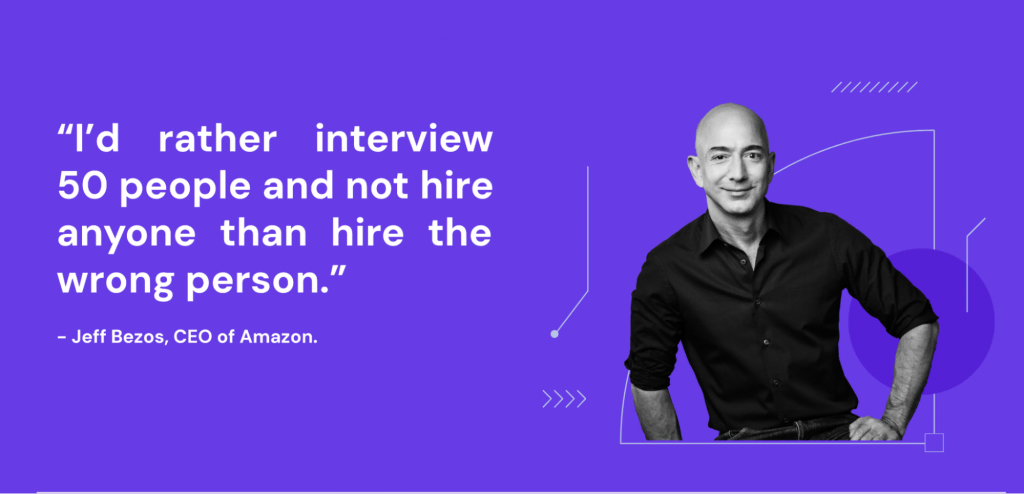Hiring the Best and Raising the Bar

From our foundation as a company back in 2004, a prospective employee’s cultural fit has always been one of the key criterias on which we’ve based recruitment decisions. Now, we want to look beyond simply ‘fitting our culture’ and ‘good enough’. Now, we’re raising the bar.
However, hiring talented and experienced people is easier said than done. That’s why we adopted the Bar Raiser approach to how we recruit staff in January 2023.
Following the Highest Standards
“At Hostinger, we do not simply fill seats with warm bodies. We seek to hire the best for Hostinger’s success. We can be proud that we have high standards and push them even higher when it comes to hiring the right people”, explains Benita Narkevičiūtė, Head of Talent Acquisition at Hostinger.
We have enshrined our constant push for high standards in our 10 Principles. These principles help guide everything we do. When it comes to hiring, we’re looking for people who can push our business and our teams forward by approaching our goals from a new angle or by bringing new expertise.

When considering a potential Hostinger employee, we ask:
- Do you strive to find the best solutions?
- Do you lead by example?
- Do you put the customer first?
- Do you take responsibility for your tasks?
The Bar Raiser process is designed to answer such questions within an interview loop.
Our goal is to raise the bar, meaning that we want to hire people who are 50% better than the current team. We are trying to hire culture peaks from different perspectives:
- They are trying to build world-class solutions and take care of our customers.
- They are role models of our principles, and they lead by example.
- They are bringing competence and industry knowledge to Hostinger, and it helps us move forward and achieve future success.
This can be a lengthy process, but if each and every person we recruit raises the bar, then the team gets progressively stronger and produces increasingly powerful results. We know from our own research that high-performing people thrive in high-performing teams. They can also be demotivated if their team isn’t performing to its capabilities.
“Some say it is expensive to have multiple interview steps; I believe it is much, much more expensive to hire the wrong person who leaves the business within six months,” says Benita Narkevičiūtė.

“When I learned that I need to hire the best possible people, I was afraid and thought, what am I going to do if the person is going to be so much better than me. It took me a few years to really embrace this thing. When you have someone so much better in some dimension than yourself, and you see how it changes things, the whole organizational class, and then it hits you that there is no other way to do this,” shares Chief Product Officer at Hostinger, Giedrius Zakaitis.
As Giedrius explains, at Hostinger, our goal is to raise our bar even higher, not as a whole, but mostly in some dimensions. We usually ask if we would hire this person and in what dimension this person would be a superstar.
Bar Raising: The Beginnings at Amazon
Back in 1999, during a period of explosive business growth, managers at Amazon were hiring without a structured interview process or consistent standards to anchor their approach and hiring decisions.
As Bryce Hanson, Co-Founder / Senior Consultant at Culture Compass and an experienced global business leader who spent nearly 20 years at Amazon leading and delivering results with business and HR teams, explains, hiring managers and interview teams were easily led by personal bias, groupthink, subjective interview feedback, and an urgency to fill seats.
“Tech teams noticed that Amazon’s bar for talent was actually being lowered. So, the technical and recruiting leadership teams put together a repeatable, scalable, and easily teachable proposal that would drive a consistent interview and hiring process. Using a common scoring system against defined and assigned competencies, the program called for each hire to be better than at least 50% of the existing team in some specific manner. An objective third party, known as the Bar Raiser, would facilitate the process end-to-end and help drive consensus on hiring decisions to raise the talent and performance bar for the company.”

The name Bar Raiser applies to both the process and the group of people – Bar Raisers – who make it happen. The process works by having a trained Bar Raiser involved in the process but not directly involved with the hiring team or the recruitment team. As a result, a Bar Raiser is free from the sense of urgency or unconscious bias that can result in poor recruitment decisions.
According to Bryce, the new interview and hiring process added an objective tension to hiring, which, coupled with a company-wide philosophy, promoted and reinforced high hiring standards. As a testament to the success of that approach, over 20 years later, Bar Raiser remains a key aspect of recruitment at Amazon.
Implementing Bar Raiser at Hostinger
A Bar Raiser is a trained interviewer in our recruitment process who ensures that the hiring decision has the most significant potential in the long-term perspective. That’s why at Hostinger, we have a few criterias for this person:
- Must be a true ambassador of Hostinger principles and demonstrate the ability to evaluate talent against our principles.
- Must be nominated by their team lead/colleagues.
- Must be skilled interviewer and complete Bar Raiser training.
- Must have strong analytical skills, an objective mindset, and be passionate about the hiring process.
“As an ambitious, global company, we are always open to taking inspiration and guidance from the world around us, especially from the best companies in the world. We take those tools, try them as they were implemented in other companies, and then make our own adjustments to have the best result,” explains Giedrius Zakaitis.
One example is the implementation of the Bar Raiser principle.
At first, we began with the same model as Amazon. Then, in mid-2023, we collaborated with Bryce Hanson to review and revamp our own process, leading to Bar Raiser 2.0.
Consequently, we expanded the Bar Raiser role. Now, it includes interview debrief facilitation, which previously was led by either the hiring manager or the recruiter. The issue was that hiring managers or recruiters were not always objective due to the pressure to hire quickly or reach their sourcing and recruiting performance goals.
“Another important change was the focus on behavioral interview questions tied specifically to Hostinger principles. This enables interview teams to assess candidates for actions, behaviors, and previous achievements that connect with Hostinger principles. A critical aspect of the process is the concept of maintaining ‘vote’ confidentiality prior to the debrief, as it creates the potential risk of groupthink. This can lead to poor hiring decisions based on individual bias and the very human desire for consensus and harmony. Now, rather than having veto at the final interview, Bar Raisers guide, advise, give feedback to, and support both the recruiter and the hiring manager at every stage of the interview process,” says Bryce Hanson.
Benita explains the roles:
- The hiring manager is the owner of the recruitment and, ultimately, a decision maker.
- The recruiter brings day-to-day expertise to coordinate the end-to-end recruitment process.
- The Bar Raiser provides objective insights as they do not feel the urgency to fill a role.
Giedrius has experienced this first hand: “As a hiring manager, it helps me cover my blind spots and raise the bar by challenging me to why. If I had to name one of the best things that I’m happiest about that we implemented recently, that would be Bar Raisers.”

We know that every candidate is evaluating Hostinger as much as we are evaluating them. Our hope is that the presence of a Bar Raiser improves the candidate’s interview experience and shows them how seriously we take each role and how much we invest in hiring and developing the best people.
Misconceptions About the Bar Raiser Process
Having participated in well over 1,000 interviews at Amazon and worked with the Bar Raiser over the last 20+ years, Bryce identifies the two main misconceptions about the process:
Bar Raisers Abuse Their Power by Vetoing Hiring Decisions Regularly
At Hostinger, hiring managers are the final decision makers supported by the Bar Raiser and recruiter. While Bar Raisers can veto a hiring manager’s decision if they feel it is not in the best interest of the company, this rarely happens. Simply put, veto power is the exception, not the rule.
The Bar Raiser Interview Is the Most Difficult Part for the Candidate
A candidate doesn’t have to prepare additionally for the Bar Raiser interview – it is a simple conversation about your values, principles, and beliefs. In addition, Bar Raisers are excellent interviewers who have a deep understanding of the culture and are trained for such calls.
Measuring the Height of the Bar
At the time of writing, we have recruited 136 people since implementing the Bar Raiser process at Hostinger.
So far, only 9% of them worked shorter than 6 months. We will continue to monitor that figure and aim for 0%. At the moment, we have introduced Peak Performance indicators and Culture Peak initiatives to measure the performance of our Bar Raiser recruits. They shine a light on those who deliver results and demonstrate outstanding behaviors across one or several of our 10 principles.
“There is still a lot of work to do,” insists Benita. “We are working with bar raisers and hiring managers, as we see a lot of potential to strengthen our interviewing skills, improve our overall understanding of recruitment, and ensure enriching candidate experience. We are in a good place, but we can be in a much better place. Luckily, we know what we need to do to get there.”
We want every person who joins Hostinger to feel proud and motivated to raise the bar even higher.



